FORD SUPER DUTY 2013 3.G Diesel Supplement Manual
Manufacturer: FORD, Model Year: 2013, Model line: SUPER DUTY, Model: FORD SUPER DUTY 2013 3.GPages: 95, PDF Size: 2.42 MB
Page 51 of 95
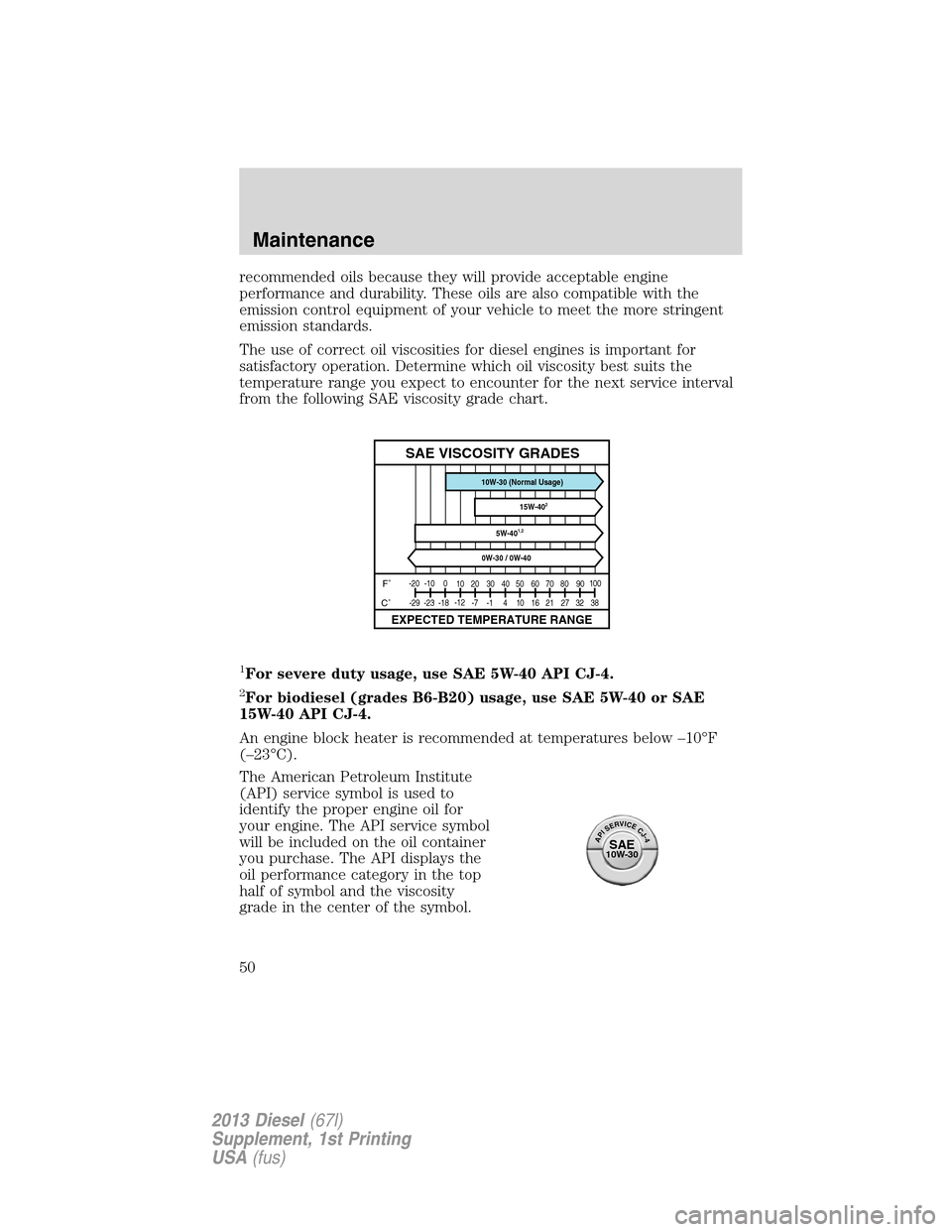
recommended oils because they will provide acceptable engine
performance and durability. These oils are also compatible with the
emission control equipment of your vehicle to meet the more stringent
emission standards.
The use of correct oil viscosities for diesel engines is important for
satisfactory operation. Determine which oil viscosity best suits the
temperature range you expect to encounter for the next service interval
from the following SAE viscosity grade chart.
1For severe duty usage, use SAE 5W-40 API CJ-4.
2For biodiesel (grades B6-B20) usage, use SAE 5W-40 or SAE
15W-40 API CJ-4.
An engine block heater is recommended at temperatures below –10°F
(–23°C).
The American Petroleum Institute
(API) service symbol is used to
identify the proper engine oil for
your engine. The API service symbol
will be included on the oil container
you purchase. The API displays the
oil performance category in the top
half of symbol and the viscosity
grade in the center of the symbol.
-20
-100
10 20 30
40
38 32 27 21 16 10 4 -1 -7 -12
-18 -23 -2950 60
7080 9010 0
SAE VISCOSITY GRADES
EXPECTED TEMPERATURE RANGE
F˚
C˚
5W-401,2
0W-30 / 0W-4015W-40
2
10W-30 (Normal Usage)
API SERVICE CJ-4
SAE10W-30
Maintenance
50
2013 Diesel(67l)
Supplement, 1st Printing
USA(fus)
Page 52 of 95
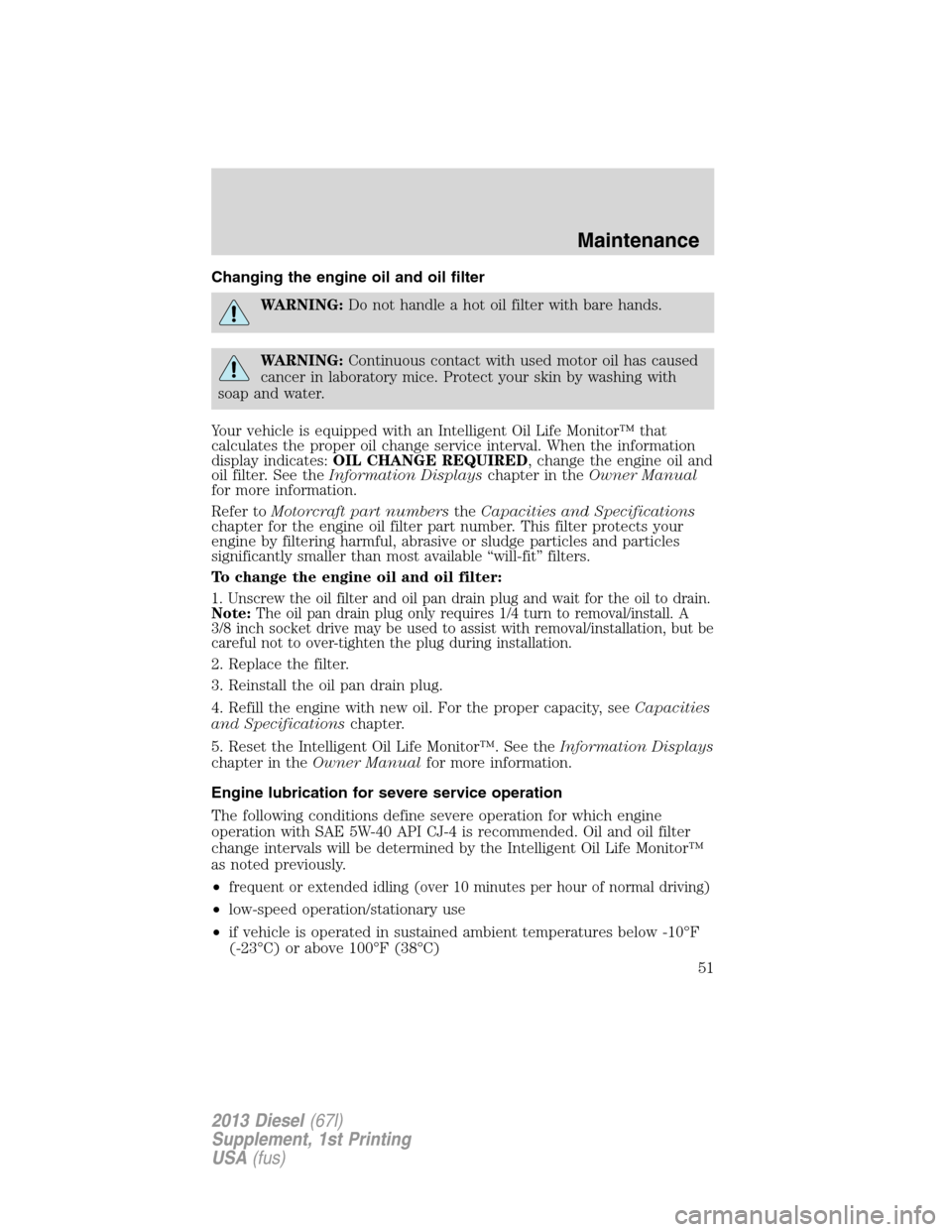
Changing the engine oil and oil filter
WARNING:Do not handle a hot oil filter with bare hands.
WARNING:Continuous contact with used motor oil has caused
cancer in laboratory mice. Protect your skin by washing with
soap and water.
Your vehicle is equipped with an Intelligent Oil Life Monitor™ that
calculates the proper oil change service interval. When the information
display indicates:OIL CHANGE REQUIRED, change the engine oil and
oil filter. See theInformation Displayschapter in theOwner Manual
for more information.
Refer toMotorcraft part numberstheCapacities and Specifications
chapter for the engine oil filter part number. This filter protects your
engine by filtering harmful, abrasive or sludge particles and particles
significantly smaller than most available “will-fit” filters.
To change the engine oil and oil filter:
1. Unscrew the oil filter and oil pan drain plug and wait for the oil to drain.
Note:The oil pan drain plug only requires 1/4 turn to removal/install. A
3/8 inch socket drive may be used to assist with removal/installation, but be
careful not to over-tighten the plug during installation.
2. Replace the filter.
3. Reinstall the oil pan drain plug.
4. Refill the engine with new oil. For the proper capacity, seeCapacities
and Specificationschapter.
5. Reset the Intelligent Oil Life Monitor™. See theInformation Displays
chapter in theOwner Manualfor more information.
Engine lubrication for severe service operation
The following conditions define severe operation for which engine
operation with SAE 5W-40 API CJ-4 is recommended. Oil and oil filter
change intervals will be determined by the Intelligent Oil Life Monitor™
as noted previously.
•
frequent or extended idling (over 10 minutes per hour of normal driving)
•low-speed operation/stationary use
•if vehicle is operated in sustained ambient temperatures below -10°F
(-23°C) or above 100°F (38°C)
Maintenance
51
2013 Diesel(67l)
Supplement, 1st Printing
USA(fus)
Page 53 of 95
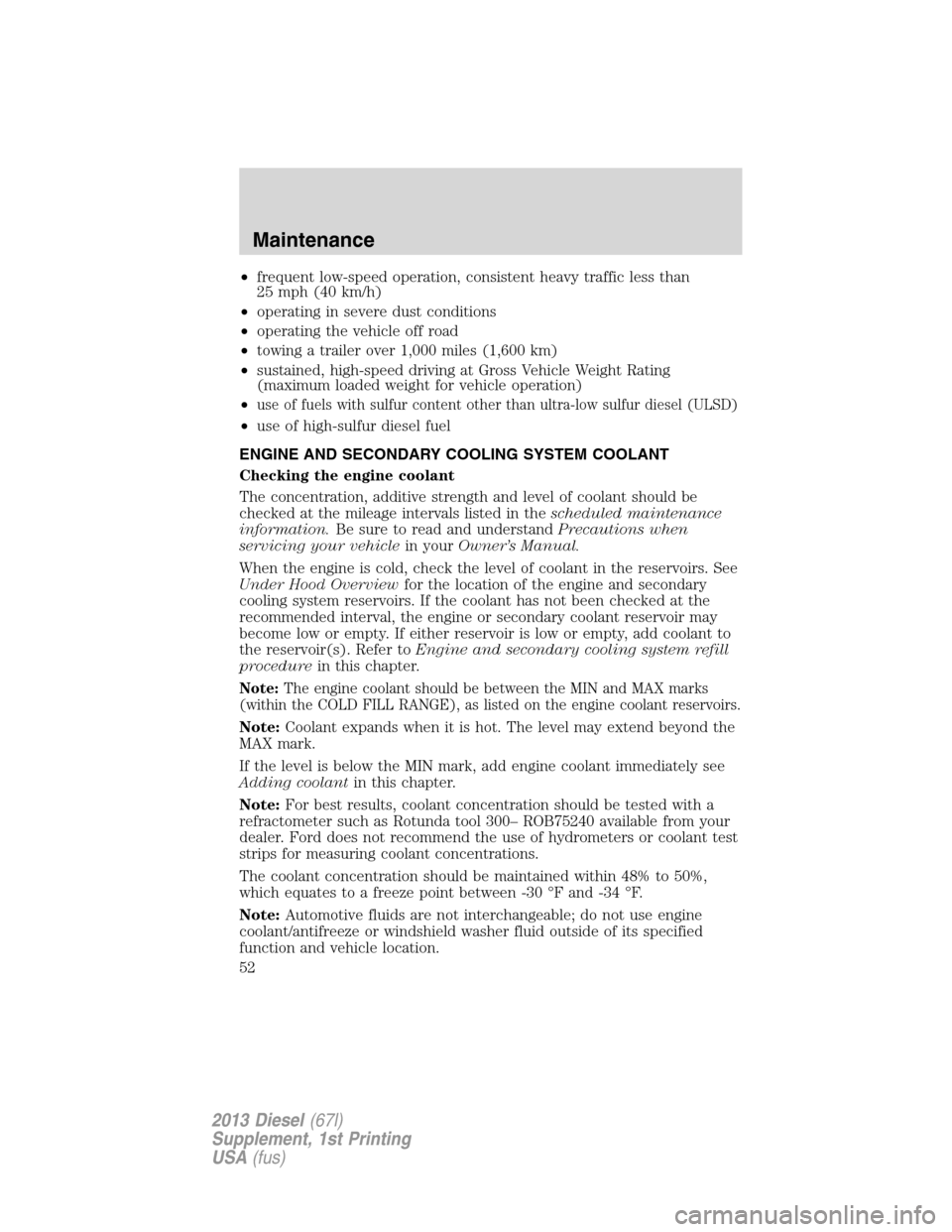
•frequent low-speed operation, consistent heavy traffic less than
25 mph (40 km/h)
•operating in severe dust conditions
•operating the vehicle off road
•towing a trailer over 1,000 miles (1,600 km)
•sustained, high-speed driving at Gross Vehicle Weight Rating
(maximum loaded weight for vehicle operation)
•
use of fuels with sulfur content other than ultra-low sulfur diesel (ULSD)
•use of high-sulfur diesel fuel
ENGINE AND SECONDARY COOLING SYSTEM COOLANT
Checking the engine coolant
The concentration, additive strength and level of coolant should be
checked at the mileage intervals listed in thescheduled maintenance
information.Be sure to read and understandPrecautions when
servicing your vehiclein yourOwner’s Manual.
When the engine is cold, check the level of coolant in the reservoirs. See
Under Hood Overviewfor the location of the engine and secondary
cooling system reservoirs. If the coolant has not been checked at the
recommended interval, the engine or secondary coolant reservoir may
become low or empty. If either reservoir is low or empty, add coolant to
the reservoir(s). Refer toEngine and secondary cooling system refill
procedurein this chapter.
Note:The engine coolant should be between the MIN and MAX marks
(within the COLD FILL RANGE), as listed on the engine coolant reservoirs.
Note:Coolant expands when it is hot. The level may extend beyond the
MAX mark.
If the level is below the MIN mark, add engine coolant immediately see
Adding coolantin this chapter.
Note:For best results, coolant concentration should be tested with a
refractometer such as Rotunda tool 300– ROB75240 available from your
dealer. Ford does not recommend the use of hydrometers or coolant test
strips for measuring coolant concentrations.
The coolant concentration should be maintained within 48% to 50%,
which equates to a freeze point between -30 °F and -34 °F.
Note:Automotive fluids are not interchangeable; do not use engine
coolant/antifreeze or windshield washer fluid outside of its specified
function and vehicle location.
Maintenance
52
2013 Diesel(67l)
Supplement, 1st Printing
USA(fus)
Page 54 of 95
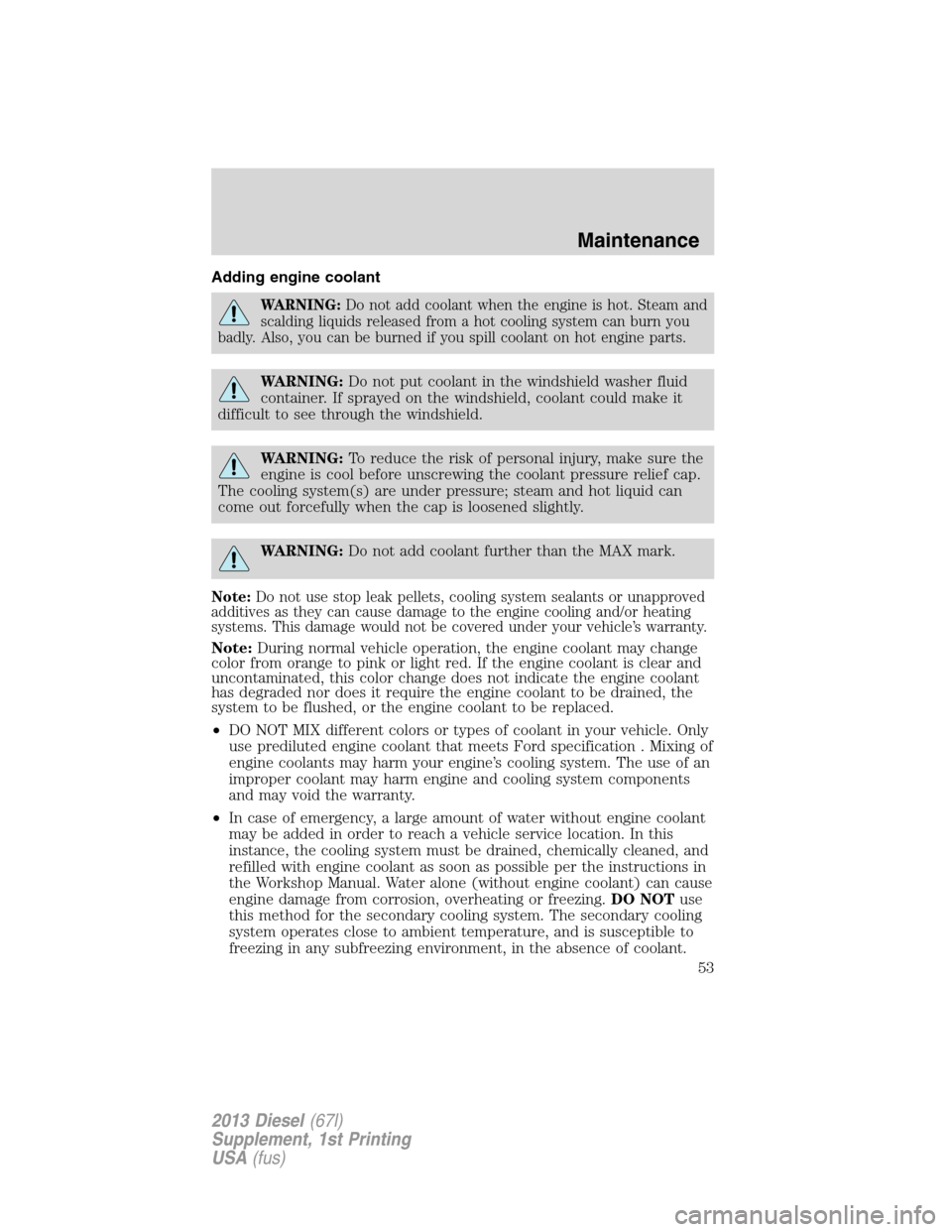
Adding engine coolant
WARNING:Do not add coolant when the engine is hot. Steam and
scalding liquids released from a hot cooling system can burn you
badly. Also, you can be burned if you spill coolant on hot engine parts.
WARNING:Do not put coolant in the windshield washer fluid
container. If sprayed on the windshield, coolant could make it
difficult to see through the windshield.
WARNING:To reduce the risk of personal injury, make sure the
engine is cool before unscrewing the coolant pressure relief cap.
The cooling system(s) are under pressure; steam and hot liquid can
come out forcefully when the cap is loosened slightly.
WARNING:Do not add coolant further than the MAX mark.
Note:Do not use stop leak pellets, cooling system sealants or unapproved
additives as they can cause damage to the engine cooling and/or heating
systems. This damage would not be covered under your vehicle’s warranty.
Note:During normal vehicle operation, the engine coolant may change
color from orange to pink or light red. If the engine coolant is clear and
uncontaminated, this color change does not indicate the engine coolant
has degraded nor does it require the engine coolant to be drained, the
system to be flushed, or the engine coolant to be replaced.
•DO NOT MIX different colors or types of coolant in your vehicle. Only
use prediluted engine coolant that meets Ford specification . Mixing of
engine coolants may harm your engine’s cooling system. The use of an
improper coolant may harm engine and cooling system components
and may void the warranty.
•In case of emergency, a large amount of water without engine coolant
may be added in order to reach a vehicle service location. In this
instance, the cooling system must be drained, chemically cleaned, and
refilled with engine coolant as soon as possible per the instructions in
the Workshop Manual. Water alone (without engine coolant) can cause
engine damage from corrosion, overheating or freezing.DO NOTuse
this method for the secondary cooling system. The secondary cooling
system operates close to ambient temperature, and is susceptible to
freezing in any subfreezing environment, in the absence of coolant.
Maintenance
53
2013 Diesel(67l)
Supplement, 1st Printing
USA(fus)
Page 55 of 95
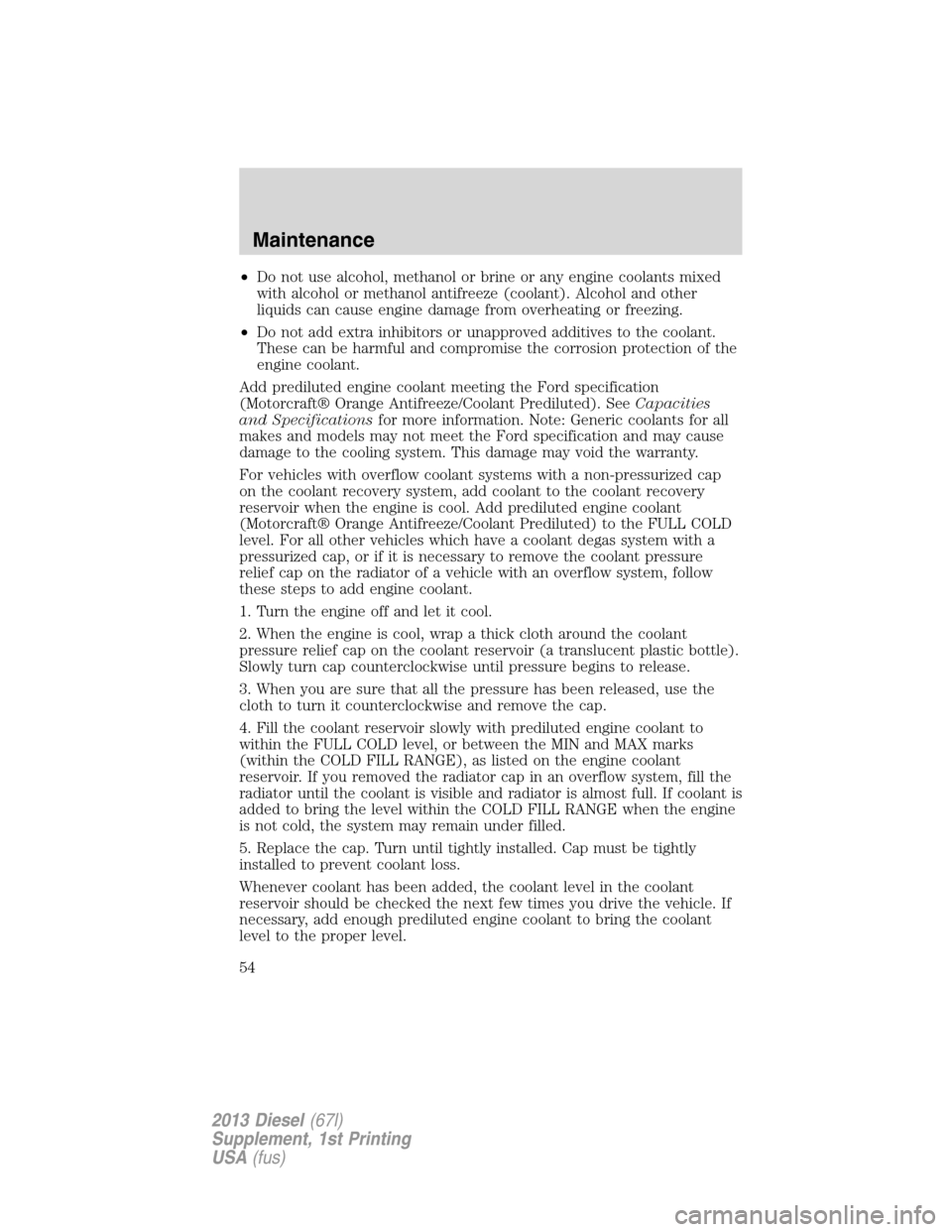
•Do not use alcohol, methanol or brine or any engine coolants mixed
with alcohol or methanol antifreeze (coolant). Alcohol and other
liquids can cause engine damage from overheating or freezing.
•Do not add extra inhibitors or unapproved additives to the coolant.
These can be harmful and compromise the corrosion protection of the
engine coolant.
Add prediluted engine coolant meeting the Ford specification
(Motorcraft® Orange Antifreeze/Coolant Prediluted). SeeCapacities
and Specificationsfor more information. Note: Generic coolants for all
makes and models may not meet the Ford specification and may cause
damage to the cooling system. This damage may void the warranty.
For vehicles with overflow coolant systems with a non-pressurized cap
on the coolant recovery system, add coolant to the coolant recovery
reservoir when the engine is cool. Add prediluted engine coolant
(Motorcraft® Orange Antifreeze/Coolant Prediluted) to the FULL COLD
level. For all other vehicles which have a coolant degas system with a
pressurized cap, or if it is necessary to remove the coolant pressure
relief cap on the radiator of a vehicle with an overflow system, follow
these steps to add engine coolant.
1. Turn the engine off and let it cool.
2. When the engine is cool, wrap a thick cloth around the coolant
pressure relief cap on the coolant reservoir (a translucent plastic bottle).
Slowly turn cap counterclockwise until pressure begins to release.
3. When you are sure that all the pressure has been released, use the
cloth to turn it counterclockwise and remove the cap.
4. Fill the coolant reservoir slowly with prediluted engine coolant to
within the FULL COLD level, or between the MIN and MAX marks
(within the COLD FILL RANGE), as listed on the engine coolant
reservoir. If you removed the radiator cap in an overflow system, fill the
radiator until the coolant is visible and radiator is almost full. If coolant is
added to bring the level within the COLD FILL RANGE when the engine
is not cold, the system may remain under filled.
5. Replace the cap. Turn until tightly installed. Cap must be tightly
installed to prevent coolant loss.
Whenever coolant has been added, the coolant level in the coolant
reservoir should be checked the next few times you drive the vehicle. If
necessary, add enough prediluted engine coolant to bring the coolant
level to the proper level.
Maintenance
54
2013 Diesel(67l)
Supplement, 1st Printing
USA(fus)
Page 56 of 95
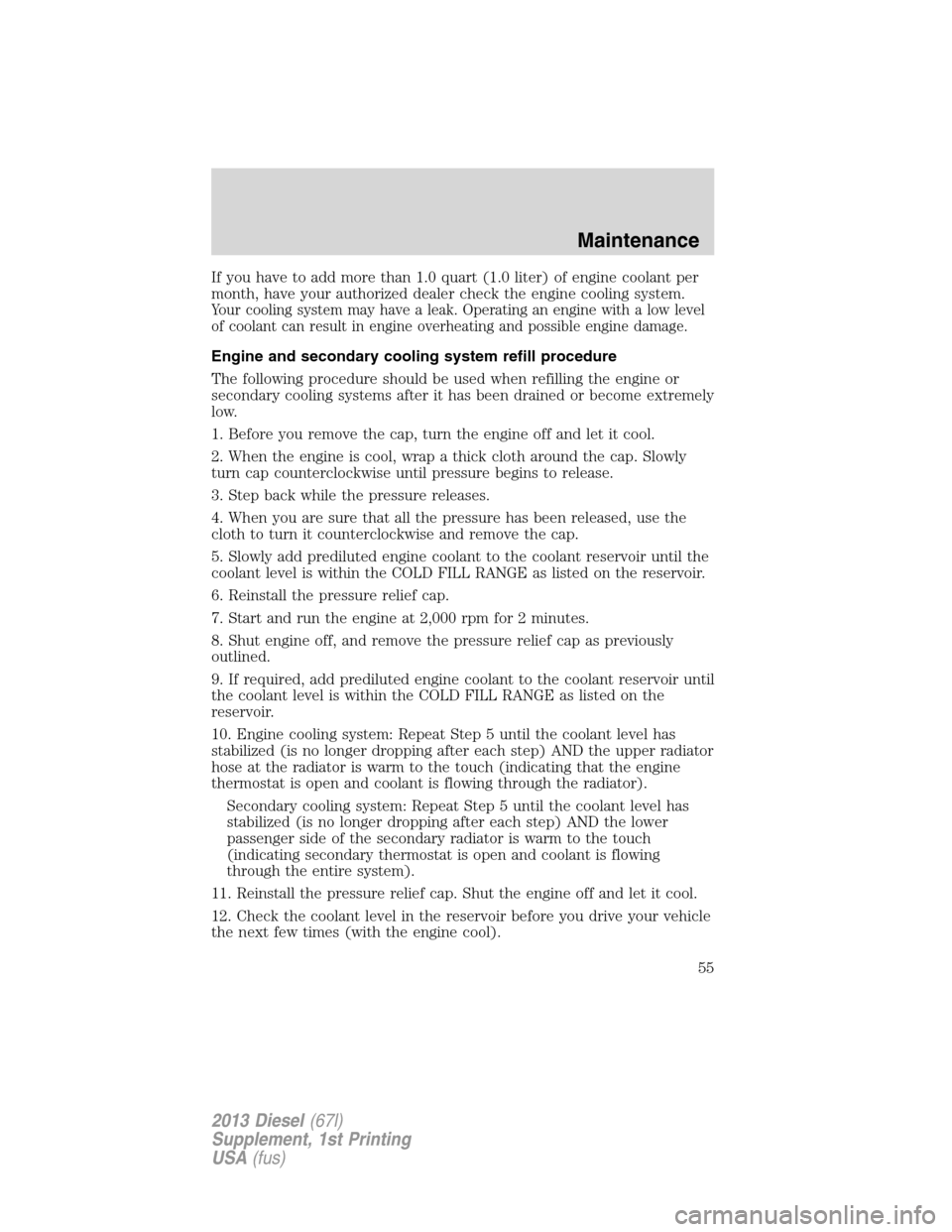
If you have to add more than 1.0 quart (1.0 liter) of engine coolant per
month, have your authorized dealer check the engine cooling system.
Your cooling system may have a leak. Operating an engine with a low level
of coolant can result in engine overheating and possible engine damage.
Engine and secondary cooling system refill procedure
The following procedure should be used when refilling the engine or
secondary cooling systems after it has been drained or become extremely
low.
1. Before you remove the cap, turn the engine off and let it cool.
2. When the engine is cool, wrap a thick cloth around the cap. Slowly
turn cap counterclockwise until pressure begins to release.
3. Step back while the pressure releases.
4. When you are sure that all the pressure has been released, use the
cloth to turn it counterclockwise and remove the cap.
5. Slowly add prediluted engine coolant to the coolant reservoir until the
coolant level is within the COLD FILL RANGE as listed on the reservoir.
6. Reinstall the pressure relief cap.
7. Start and run the engine at 2,000 rpm for 2 minutes.
8. Shut engine off, and remove the pressure relief cap as previously
outlined.
9. If required, add prediluted engine coolant to the coolant reservoir until
the coolant level is within the COLD FILL RANGE as listed on the
reservoir.
10. Engine cooling system: Repeat Step 5 until the coolant level has
stabilized (is no longer dropping after each step) AND the upper radiator
hose at the radiator is warm to the touch (indicating that the engine
thermostat is open and coolant is flowing through the radiator).
Secondary cooling system: Repeat Step 5 until the coolant level has
stabilized (is no longer dropping after each step) AND the lower
passenger side of the secondary radiator is warm to the touch
(indicating secondary thermostat is open and coolant is flowing
through the entire system).
11. Reinstall the pressure relief cap. Shut the engine off and let it cool.
12. Check the coolant level in the reservoir before you drive your vehicle
the next few times (with the engine cool).
Maintenance
55
2013 Diesel(67l)
Supplement, 1st Printing
USA(fus)
Page 57 of 95
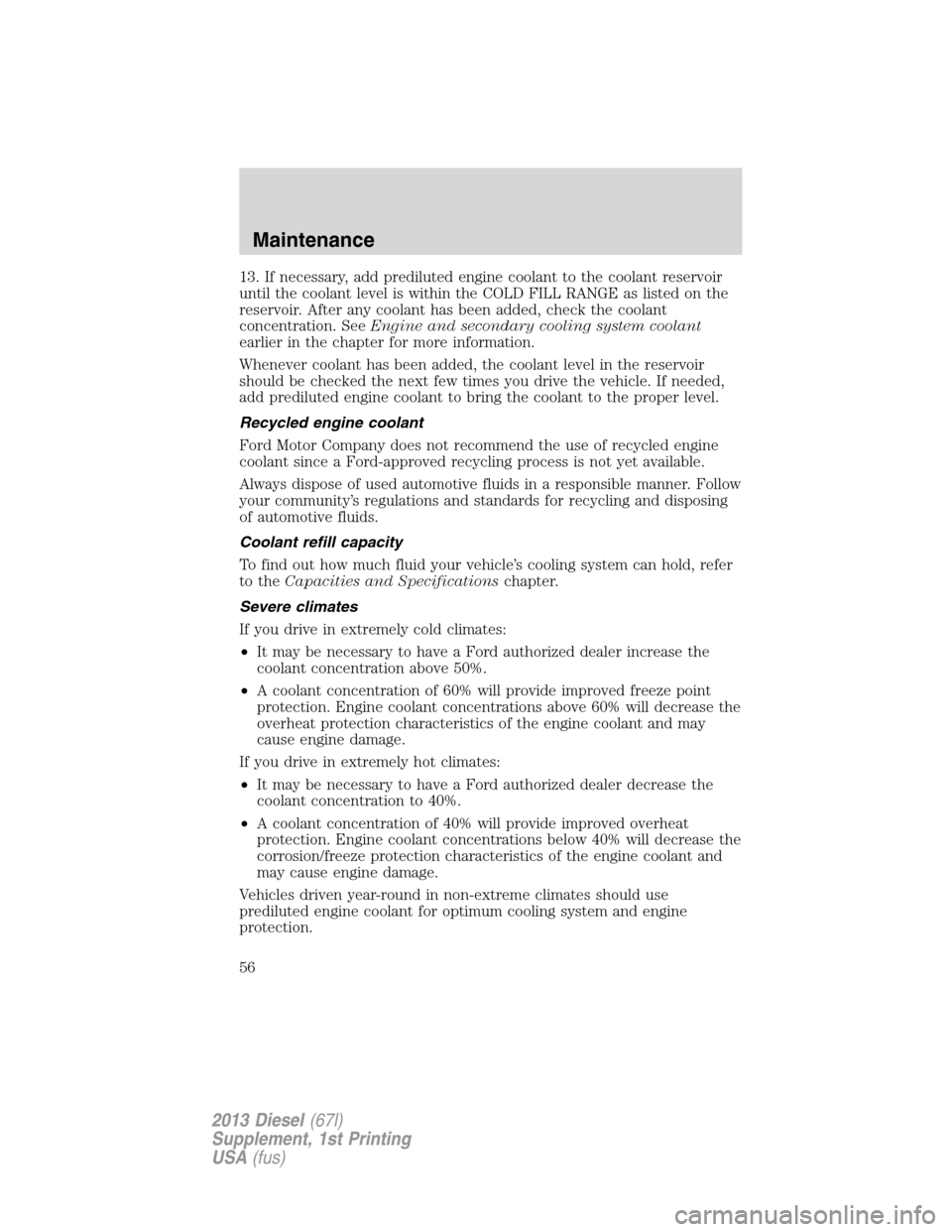
13. If necessary, add prediluted engine coolant to the coolant reservoir
until the coolant level is within the COLD FILL RANGE as listed on the
reservoir. After any coolant has been added, check the coolant
concentration. SeeEngine and secondary cooling system coolant
earlier in the chapter for more information.
Whenever coolant has been added, the coolant level in the reservoir
should be checked the next few times you drive the vehicle. If needed,
add prediluted engine coolant to bring the coolant to the proper level.
Recycled engine coolant
Ford Motor Company does not recommend the use of recycled engine
coolant since a Ford-approved recycling process is not yet available.
Always dispose of used automotive fluids in a responsible manner. Follow
your community’s regulations and standards for recycling and disposing
of automotive fluids.
Coolant refill capacity
To find out how much fluid your vehicle’s cooling system can hold, refer
to theCapacities and Specificationschapter.
Severe climates
If you drive in extremely cold climates:
•It may be necessary to have a Ford authorized dealer increase the
coolant concentration above 50%.
•A coolant concentration of 60% will provide improved freeze point
protection. Engine coolant concentrations above 60% will decrease the
overheat protection characteristics of the engine coolant and may
cause engine damage.
If you drive in extremely hot climates:
•It may be necessary to have a Ford authorized dealer decrease the
coolant concentration to 40%.
•A coolant concentration of 40% will provide improved overheat
protection. Engine coolant concentrations below 40% will decrease the
corrosion/freeze protection characteristics of the engine coolant and
may cause engine damage.
Vehicles driven year-round in non-extreme climates should use
prediluted engine coolant for optimum cooling system and engine
protection.
Maintenance
56
2013 Diesel(67l)
Supplement, 1st Printing
USA(fus)
Page 58 of 95
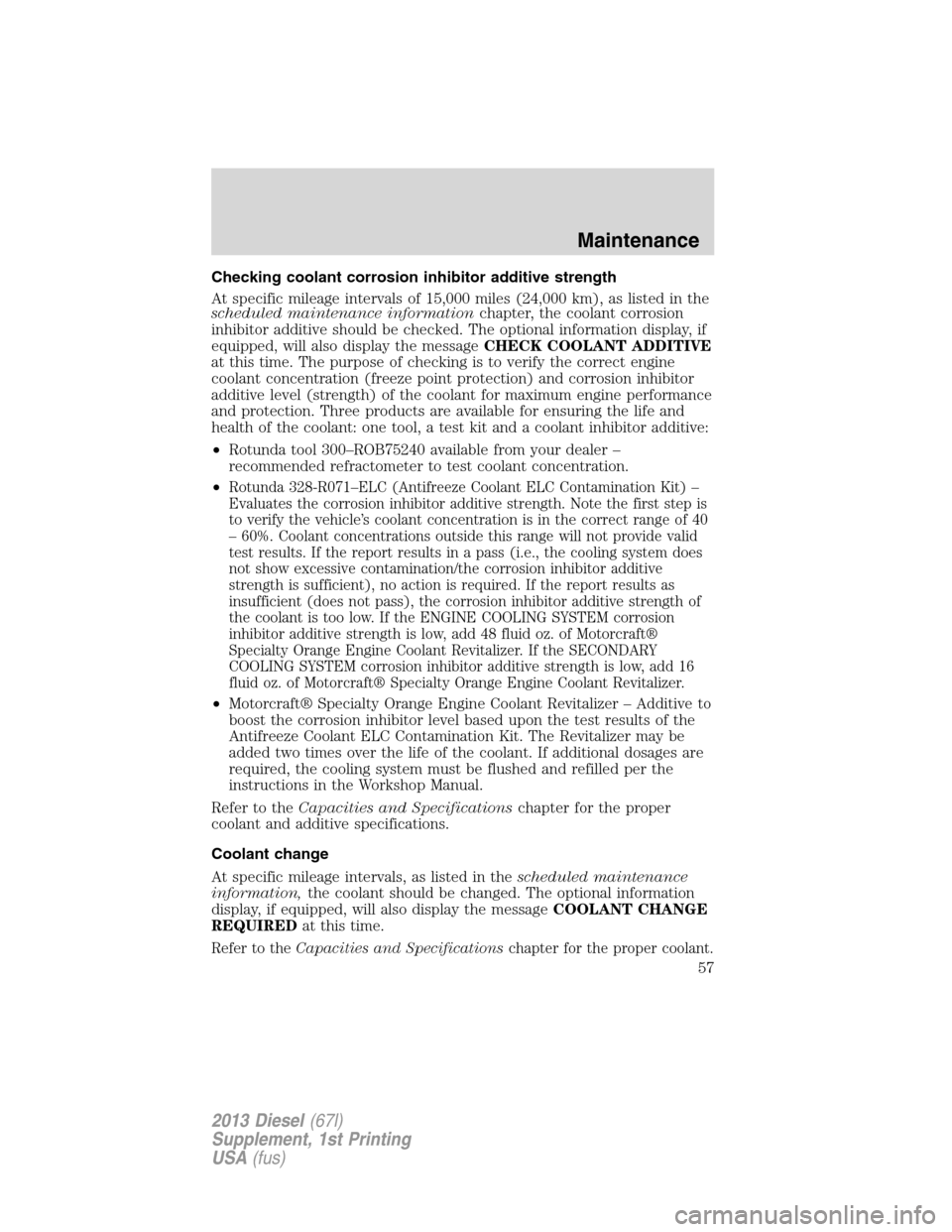
Checking coolant corrosion inhibitor additive strength
At specific mileage intervals of 15,000 miles (24,000 km), as listed in the
scheduled maintenance informationchapter, the coolant corrosion
inhibitor additive should be checked. The optional information display, if
equipped, will also display the messageCHECK COOLANT ADDITIVE
at this time. The purpose of checking is to verify the correct engine
coolant concentration (freeze point protection) and corrosion inhibitor
additive level (strength) of the coolant for maximum engine performance
and protection. Three products are available for ensuring the life and
health of the coolant: one tool, a test kit and a coolant inhibitor additive:
•Rotunda tool 300–ROB75240 available from your dealer –
recommended refractometer to test coolant concentration.
•
Rotunda 328-R071–ELC (Antifreeze Coolant ELC Contamination Kit) –
Evaluates the corrosion inhibitor additive strength. Note the first step is
to verify the vehicle’s coolant concentration is in the correct range of 40
– 60%. Coolant concentrations outside this range will not provide valid
test results. If the report results in a pass (i.e., the cooling system does
not show excessive contamination/the corrosion inhibitor additive
strength is sufficient), no action is required. If the report results as
insufficient (does not pass), the corrosion inhibitor additive strength of
the coolant is too low. If the ENGINE COOLING SYSTEM corrosion
inhibitor additive strength is low, add 48 fluid oz. of Motorcraft®
Specialty Orange Engine Coolant Revitalizer. If the SECONDARY
COOLING SYSTEM corrosion inhibitor additive strength is low, add 16
fluid oz. of Motorcraft® Specialty Orange Engine Coolant Revitalizer.
•Motorcraft® Specialty Orange Engine Coolant Revitalizer – Additive to
boost the corrosion inhibitor level based upon the test results of the
Antifreeze Coolant ELC Contamination Kit. The Revitalizer may be
added two times over the life of the coolant. If additional dosages are
required, the cooling system must be flushed and refilled per the
instructions in the Workshop Manual.
Refer to theCapacities and Specificationschapter for the proper
coolant and additive specifications.
Coolant change
At specific mileage intervals, as listed in thescheduled maintenance
information,the coolant should be changed. The optional information
display, if equipped, will also display the messageCOOLANT CHANGE
REQUIREDat this time.
Refer to theCapacities and Specificationschapter for the proper coolant.
Maintenance
57
2013 Diesel(67l)
Supplement, 1st Printing
USA(fus)
Page 59 of 95
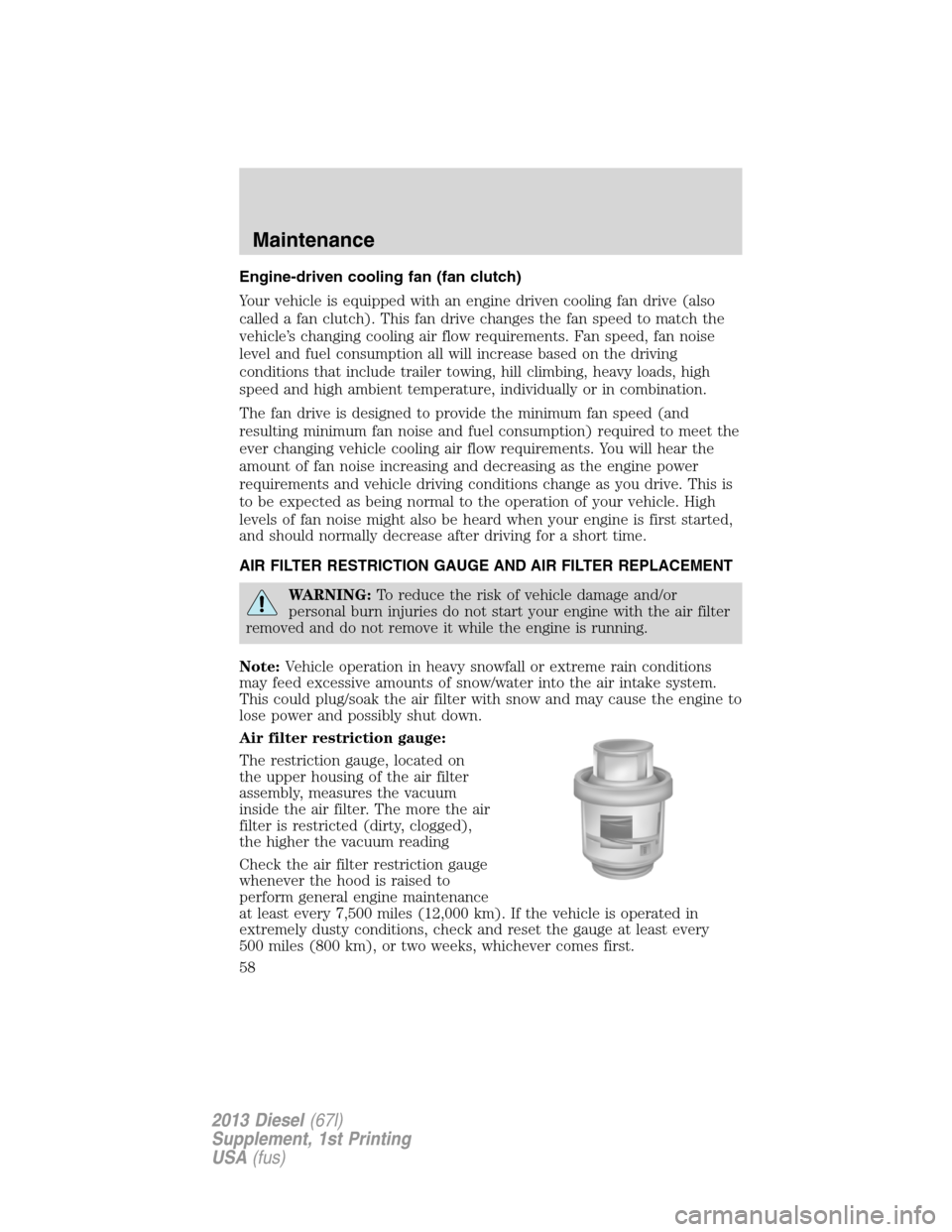
Engine-driven cooling fan (fan clutch)
Your vehicle is equipped with an engine driven cooling fan drive (also
called a fan clutch). This fan drive changes the fan speed to match the
vehicle’s changing cooling air flow requirements. Fan speed, fan noise
level and fuel consumption all will increase based on the driving
conditions that include trailer towing, hill climbing, heavy loads, high
speed and high ambient temperature, individually or in combination.
The fan drive is designed to provide the minimum fan speed (and
resulting minimum fan noise and fuel consumption) required to meet the
ever changing vehicle cooling air flow requirements. You will hear the
amount of fan noise increasing and decreasing as the engine power
requirements and vehicle driving conditions change as you drive. This is
to be expected as being normal to the operation of your vehicle. High
levels of fan noise might also be heard when your engine is first started,
and should normally decrease after driving for a short time.
AIR FILTER RESTRICTION GAUGE AND AIR FILTER REPLACEMENT
WARNING:To reduce the risk of vehicle damage and/or
personal burn injuries do not start your engine with the air filter
removed and do not remove it while the engine is running.
Note:Vehicle operation in heavy snowfall or extreme rain conditions
may feed excessive amounts of snow/water into the air intake system.
This could plug/soak the air filter with snow and may cause the engine to
lose power and possibly shut down.
Air filter restriction gauge:
The restriction gauge, located on
the upper housing of the air filter
assembly, measures the vacuum
inside the air filter. The more the air
filter is restricted (dirty, clogged),
the higher the vacuum reading
Check the air filter restriction gauge
whenever the hood is raised to
perform general engine maintenance
at least every 7,500 miles (12,000 km). If the vehicle is operated in
extremely dusty conditions, check and reset the gauge at least every
500 miles (800 km), or two weeks, whichever comes first.
Maintenance
58
2013 Diesel(67l)
Supplement, 1st Printing
USA(fus)
Page 60 of 95
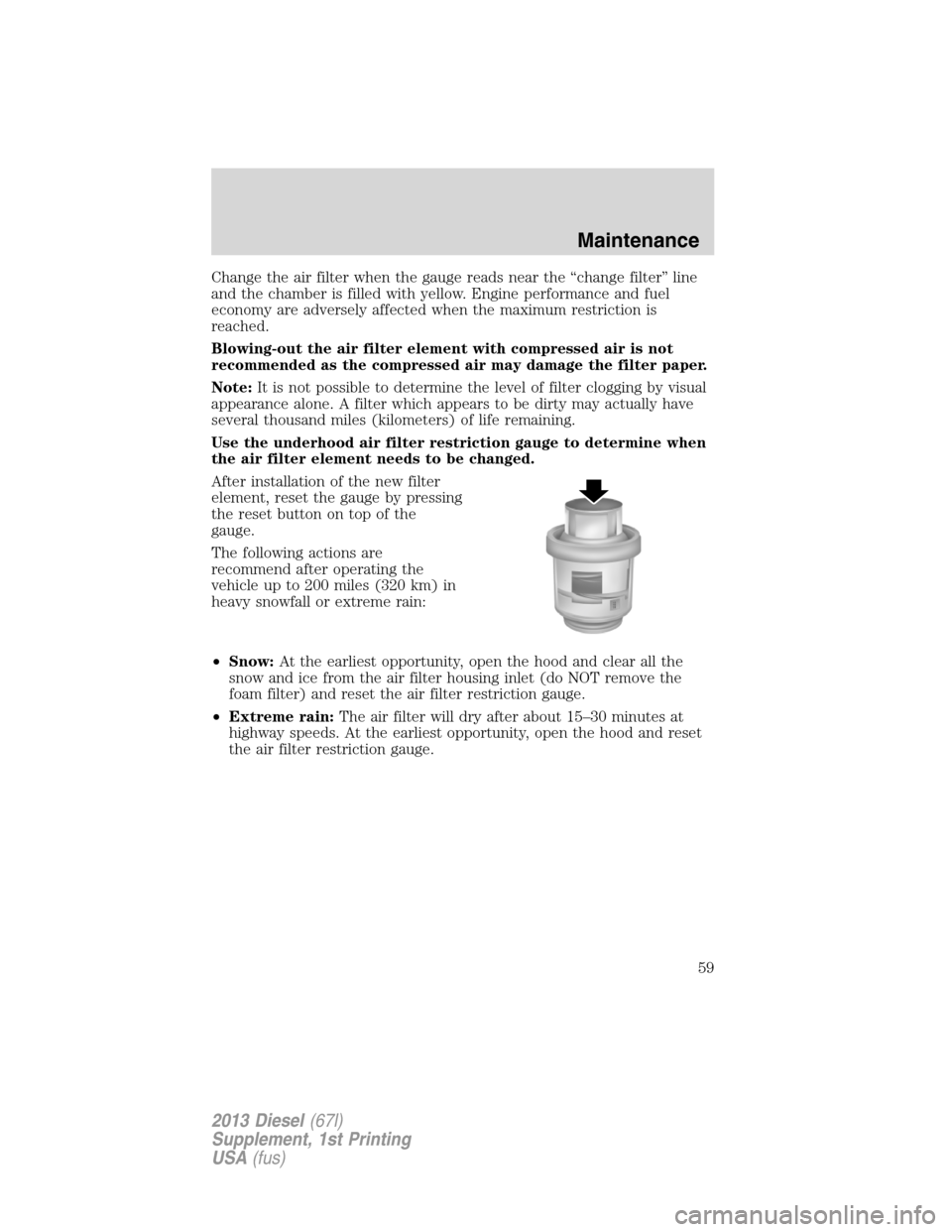
Change the air filter when the gauge reads near the “change filter” line
and the chamber is filled with yellow. Engine performance and fuel
economy are adversely affected when the maximum restriction is
reached.
Blowing-out the air filter element with compressed air is not
recommended as the compressed air may damage the filter paper.
Note:It is not possible to determine the level of filter clogging by visual
appearance alone. A filter which appears to be dirty may actually have
several thousand miles (kilometers) of life remaining.
Use the underhood air filter restriction gauge to determine when
the air filter element needs to be changed.
After installation of the new filter
element, reset the gauge by pressing
the reset button on top of the
gauge.
The following actions are
recommend after operating the
vehicle up to 200 miles (320 km) in
heavy snowfall or extreme rain:
•Snow:At the earliest opportunity, open the hood and clear all the
snow and ice from the air filter housing inlet (do NOT remove the
foam filter) and reset the air filter restriction gauge.
•Extreme rain:The air filter will dry after about 15–30 minutes at
highway speeds. At the earliest opportunity, open the hood and reset
the air filter restriction gauge.
Maintenance
59
2013 Diesel(67l)
Supplement, 1st Printing
USA(fus)